If you’re a first-time dog owner, you’d be hard-pressed to find a better breed than the English setter. They are sweet, energetic people-pleasers, who want nothing more than a romp in the woods and some affection when they get home.
They have gorgeous markings in sleek, silky coats that lead to many people mistaking them for long-haired dalmatians, but they don’t let their good looks go to their heads.
English setters are energetic, so they need regular exercise and a fenced-in area to romp and play, as well as a comfy couch to snuggle on in the evenings. They are wonderful with children and tolerate all kinds of shenanigans, as long as they are getting attention!
If you’re looking for an intelligent companion to accompany you on life’s adventures, the English setter might be a perfect fit.
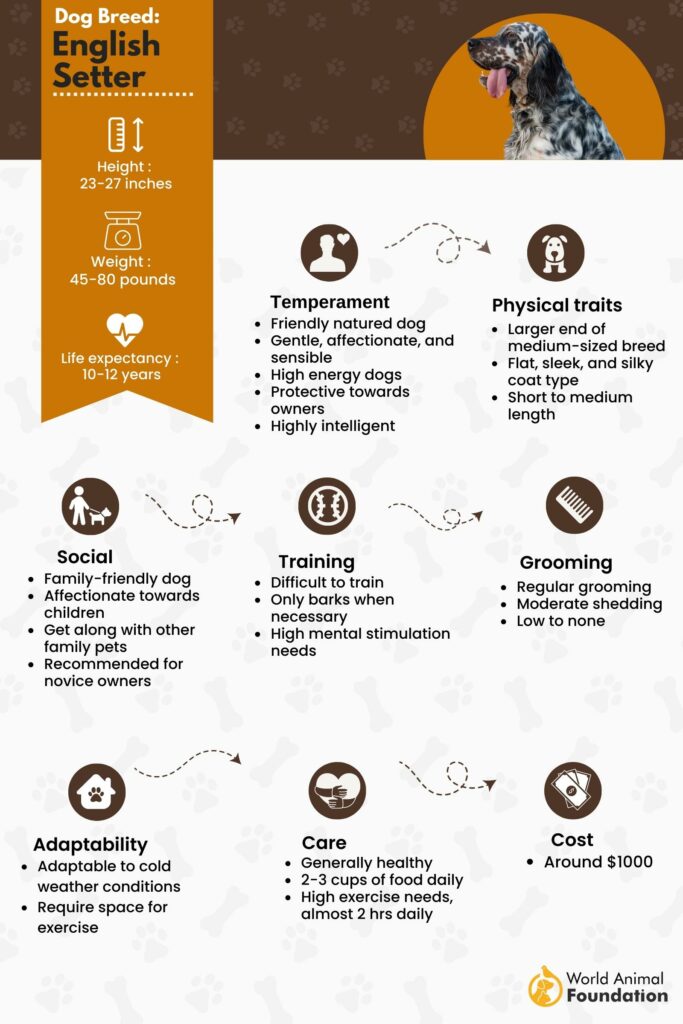
About the Breed
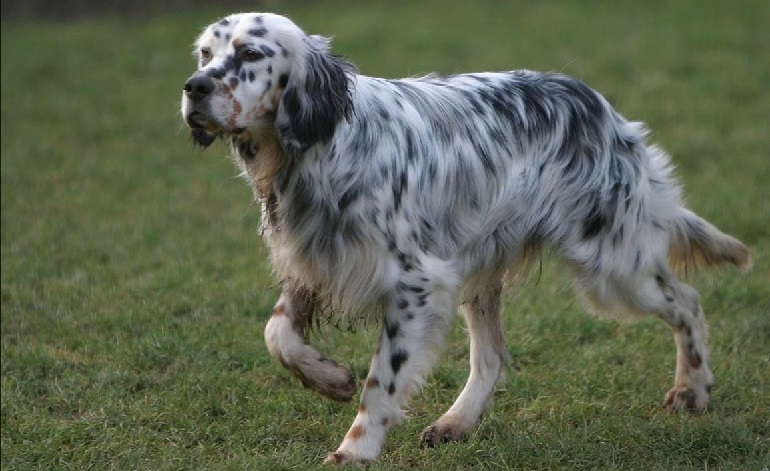
The English Setter is basically the Zoolander of sporting dogs: they have a super sweet temperament and are really, ridiculously good-looking. Bred for a mix of endurance and athleticism, setters are methodical scent-hunters who can run great distances, and are preferred as hunting dogs the world over.
However, they’re also known for making fantastic family pets. The American Kennel Club gives them the highest ranking in their “affectionate with family” scale, also known as “lovey-dovey.” They’re really good with children, never meet a stranger they don’t like, and they love to play.
The one (possible) downside is that, unlike Zoolander, the English setter is typically really bright, and they require a lot of exercise to help them work out their abundance of energy. If bored, English setters can become quite mischievous, so it’s not a good idea to have one if you prefer a sedentary lifestyle.
Vital Stats
The average height of an adult dog is 25-27 inches for a male, measured from the floor to the top of its shoulders, and 23-25 inches for a typical female dog. The males usually weigh between 65-80 pounds, and the females average between 45-55 pounds.
There tends to be a disparity between the sizes of the dogs, depending on which strain — field or show — they are descended from. The average life span of an English Setter is 12 years, which is pretty decent for this size canine.
History of English Setters
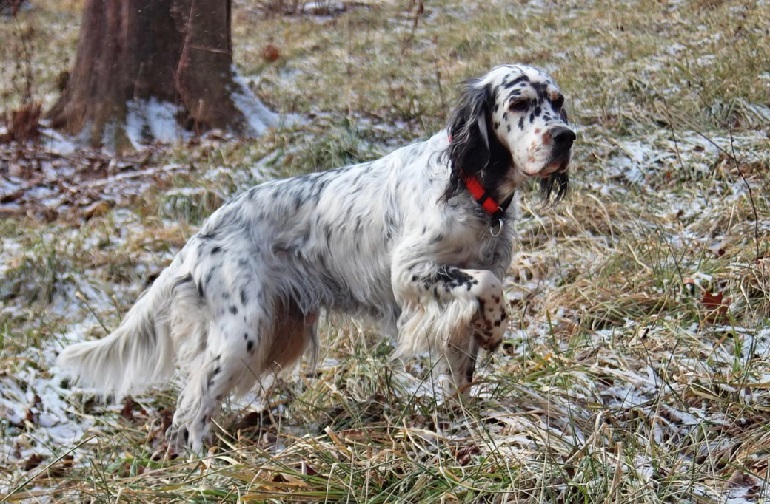
The English Setter – distinguished from other “setters” just because of where they originated – was first recognized as a trained bird dog in England more than 400 years ago. In fact, there are examples of artwork from the early 15th century showing dogs that are definitely a “setter type.” (How dare they judge someone like that?)
It is thought that the breed is a result of crossing Spanish Pointers, Water Spaniels, and the English Springer Spaniel to produce an excellent hunting dog with a high degree of proficiency in finding and pointing game birds.
“Setting dogges,” as they were called in the 17th century before people learned to spell (just kidding), became ubiquitous on British estates, as birding was an incredibly popular sport amongst the landed elite. The term evolved because the dogs were expected to lay down quietly, or to “set,” when they located game birds.
This style of hunting at the time would then require the hunter to cast a net in the area, sometimes covering the dog as well, and flush and harvest the birds that were ensnared.
Any breed that “set” was then branded a setter. (So, you’re saying that when I lay down in bed and refuse to move until someone throws a blanket over me, I’m a setter, too?)
In the 1800s, two strains of English Setter were developed and popularized thanks to some really obsessive English dudes. Edward Laverack developed his own strain through the careful breeding of two particular dogs, “Ponto” and “Old Moll.”
At the same time, Richard Purcell Llewellin used some of Laverack’s best dogs and outcrossed them with his dogs, “Duke,” “Phoebe,” and later, “Kate,” to create essentially what we know of as the modern English Setter.
Llewellyn did produce a personal strain, known as “Dashing Bondhu” in 1925, which was interbred purely by a man named William Humphrey in 1963. Although many people will refer to their dog as “a Llewellyn” or “a Laverack,” the terms are often mistakenly used interchangeably and mostly when people are being snobby about their dogs.
The biggest difference between the two is that Llewellyn primarily focused breeding based on field performance (hunting), while Laverack mostly associated with the dogs destined to be show setters.
Types of Setters
Here is a list of different types of Setters with their brief introduction.
Field Type
Field-type setters, sometimes called Llewellin setters, are usually smaller than the show types, with a finer build so they can cover greater distances more easily. They also have less feathering in their fur on the backs of their legs, bums, and tail, so they require less grooming.
The ones used for hunting typically have more distinctive spotting of color than the show-type setters, which is kind of counterintuitive when you think about it.
Show Type
The show type of English Setter, or Laverack setter, has long, luxurious feathered fur, which requires regular grooming to maintain. And the patches of color that are often seen in the field dogs aren’t desirable for show dogs (because those judges be judgey), so they tend to have fewer color variations.
The show type also runs a bit bigger than the field type, but that doesn’t really slow them down.
English Setter Traits and Characteristics
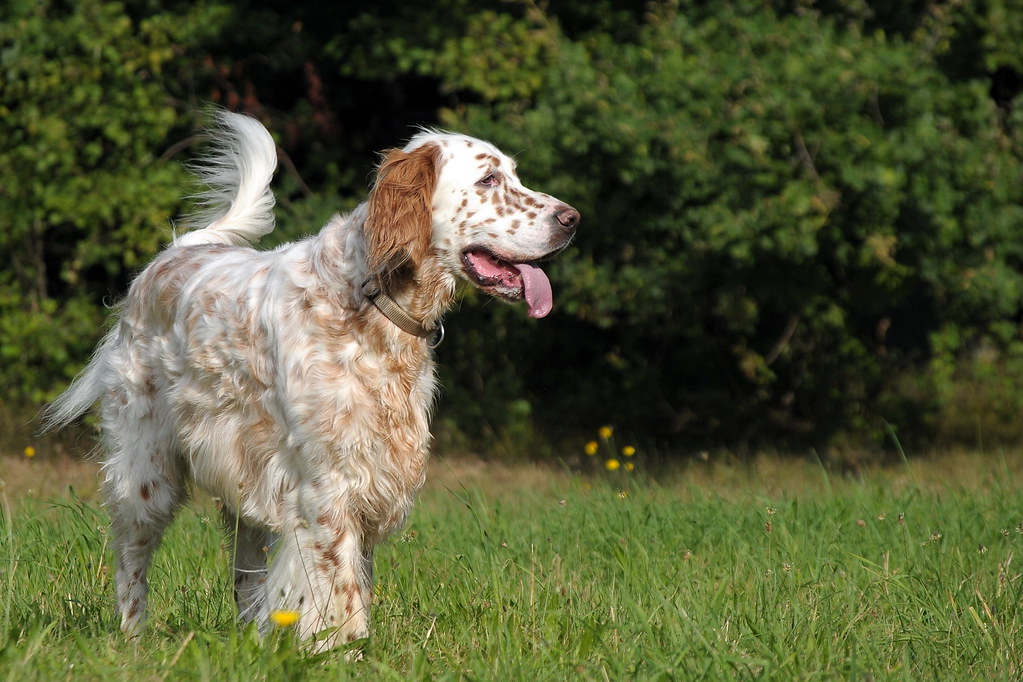
The English Setter looks a bit like a cross between a Great Dane, a Spanish Pointer, and a Cocker Spaniel. (We’re pretty sure we’ve heard jokes that start like that…) This breed is described as a medium-sized dog with a slightly domed head, floppy ears, and expressive, gentle eyes. You should see the puppy eyes they give!
As pets, they are pretty adaptable, and their friendly natures make them excellent family members. However, they do not do well being left alone for long periods of time; their intelligence and drive require a lot of attention and mental stimulation.
The good thing is that they require regular exercise, but they aren’t as needy as other sporting breeds; just make sure they can have a vigorous workout twice a day, as opposed to a sedate walk. They can be prone to separation anxiety, so they do better in a home where they’ll have plenty of companionship.
English Setter Appearance
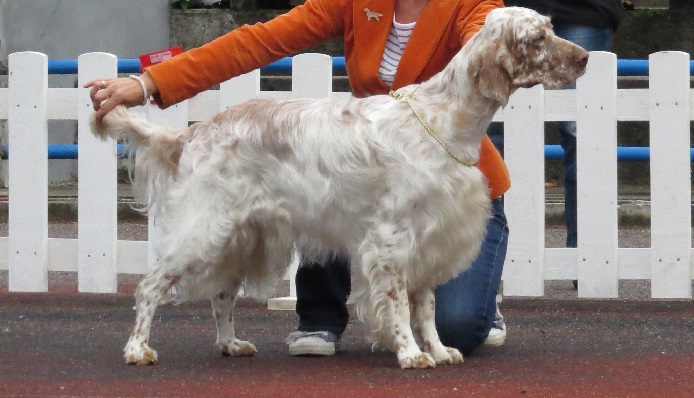
Considered a medium-sized dog, an English Setter tends to weigh between 55-80 pounds if they’re male, and between 45-55 pounds if female. Their silky, medium-length coats require frequent grooming to prevent tangles and matting, particularly behind the ears, legs, and on tail.
The base color of the coat is white with different colored ticking, which is also called flecks or speckling. Laverack coined the term “belton” to describe his ideal for flecking after the name of a village in northern England, and today there are several different varieties:
- Blue Belton: white with black markings, or flecks
- Orange Belton: white with orange flecks
- Lemon Belton: white with orange flecks and a lighter nose
- Liver Belton: white with liver flecks
- Tricolor: blue or liver belton with tan markings on the face, chest, and legs.
For show-type setters, the flecking shouldn’t form large patches on the body, and the flecks should be evenly distributed all over. Their flecks also develop as they mature, so puppies’ coats may look very different than the adult dogs’.
In fact, English setter puppies are usually born white, so if someone tries to sell you a white setter, you can tell them you weren’t born yesterday.
English Setter Temperament and Personality
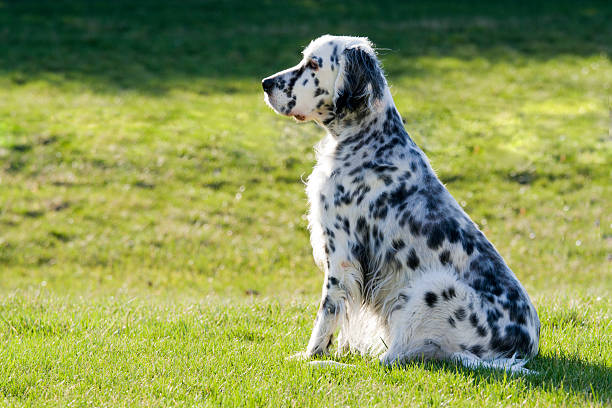
The English setter is known as the “gentleman of the dog world.” They are gentle, affectionate, and intelligent. If they get bored (which can happen easily,) they can be prone to bouts of willfulness.
They are also sensitive: even gentle scolding tends to hurt their feelings, so they respond better to positive reinforcement techniques when training.
They really are the best of both worlds: they need plenty of exercise outdoors — it’s a good idea to have a fenced area for them to play in — but when they’re indoors, they are just lovable couch potatoes.
English Setter Health and Care
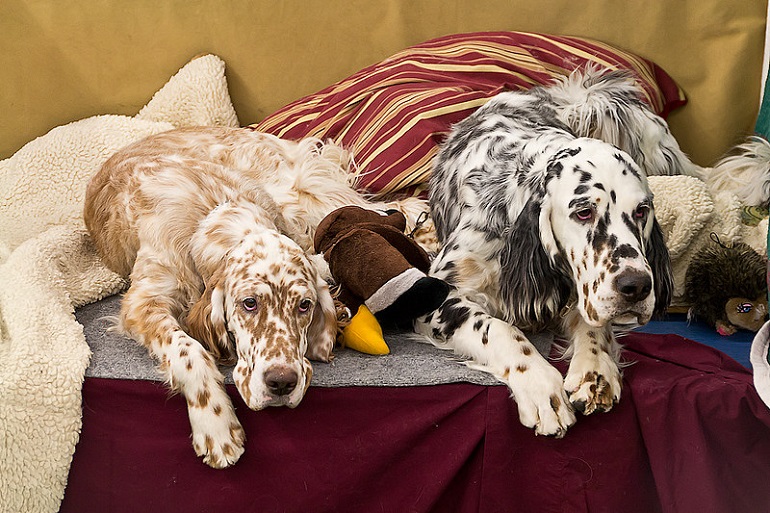
While most English setters are generally healthy dogs, especially if they come from a reputable breeder, they are prone to several genetic health problems.
Approximately 12.4% of English setters suffer from congenital deafness, and 26.2% are likely to have autoimmune thyroiditis (otherwise known as hypothyroidism: a disorder of the endocrine system in which the thyroid gland does not produce enough thyroid hormones.)
When the thyroid is underproductive, it can lead to weight gain and depression, so this is another good reason to make sure your English Setter gets enough exercise.
Because they were bred to enjoy running after game birds, these dogs are prone to roaming, digging, and jumping. They would definitely need a fenced yard to play in, in addition to several brisk walks a day.
Other health issues they are prone to include elbow dysplasia (an overgrowth of cartilage that presents as osteoarthritis), hip dysplasia, and allergies to certain food ingredients that can lead to various skin conditions.
The English setter has a long coat with feathering, particularly the Laverack setters, so regular brushing and grooming are necessary. Those feathers also prevent a lot of air flow into their ears, so it’s a good idea to clean those out regularly too, to prevent infections from developing. It can also be treated with the help of CBD Oil for hip dysplasia.
Unfortunately, like many other breeds, the adult English Setter is prone to many types of cancer.
English Setter Food and Diet
Your English Setter gains weight easily, so monitor your dog’s diet carefully and adjust accordingly to keep them at a healthy weight.
If your English setter is particularly active – like if they’re being used in the field – it’s important to make sure they’re getting enough calories. However, if your setter is getting older and prefers the couch potato lifestyle, you might want to keep a careful eye on their food intake.
Thankfully, the English setter breed is food-motivated, and they’re very rarely picky about their food choices. If you notice itching and scratching that leads to redness, hair loss, or damaged skin, it could be a sign they are allergic to something in their food.
Similarly, they are prone to food sensitivities, so excessive farting and upset stomach symptoms need to be looked for as well.
English Setter in Sports
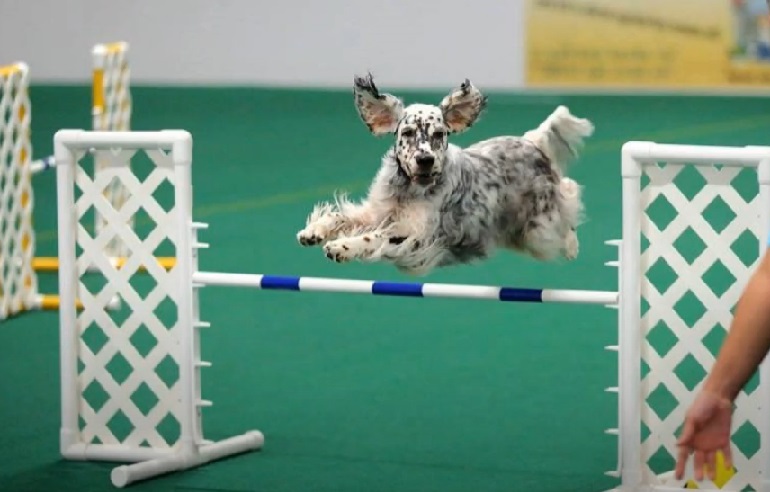
The English setter dog breed, like most sporting dogs, is highly motivated to work closely with and for their people, and they are physically adapted to have great agility and stamina. These two traits make them ideal for competing in agility trials, jumping, and hunting.
The AKC classifies the English setter in the sporting dog category, and in 2022 a beautiful 4-year-old liver Beldon named Belle won the top prize at Westminster Dog Show.
How Does the English Setter Function?
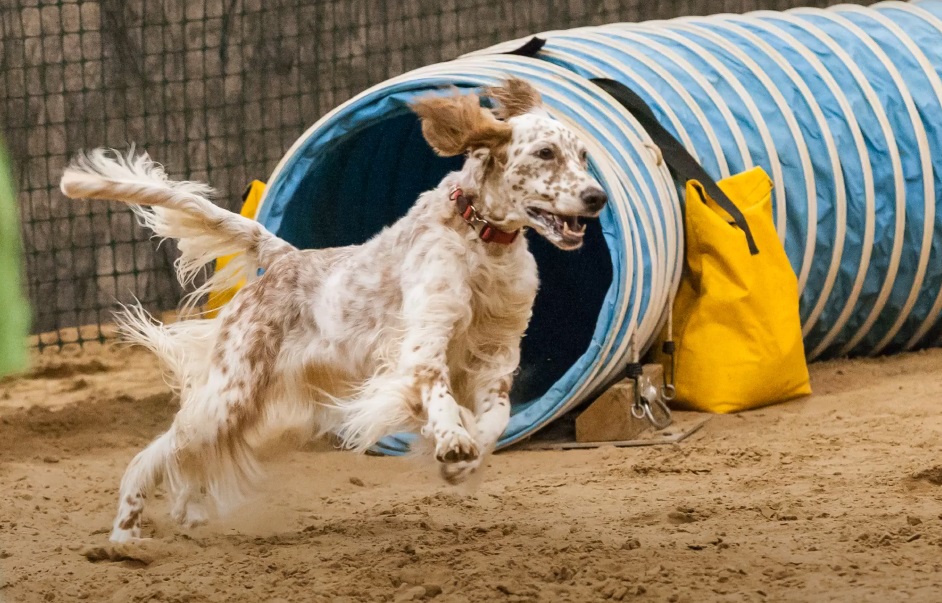
When an English Setter is on the job, they are formidable. They range over large distances in a systematic, methodical manner, sniffing out the game with a highly sensitive nose.
When they locate their prey, the setter will freeze, and “set” in a sort of crouching stance, and then stay that way until they get the command to flush out the game.
When this method using the dog was first employed, the hunter would then release hawks to capture the fleeing birds. Then, as the sport evolved, the gamesmen would employ various methods, including nets and then firearms. Either way, the English Setter’s job never changed: locate the prey by airborne scent and then point it out.
Most are born with a natural proclivity toward hunting, but trainers will specifically pick out English Setter puppies if they are “birdy,” or show excitement and interest in birds.
Fun Facts About English Setters
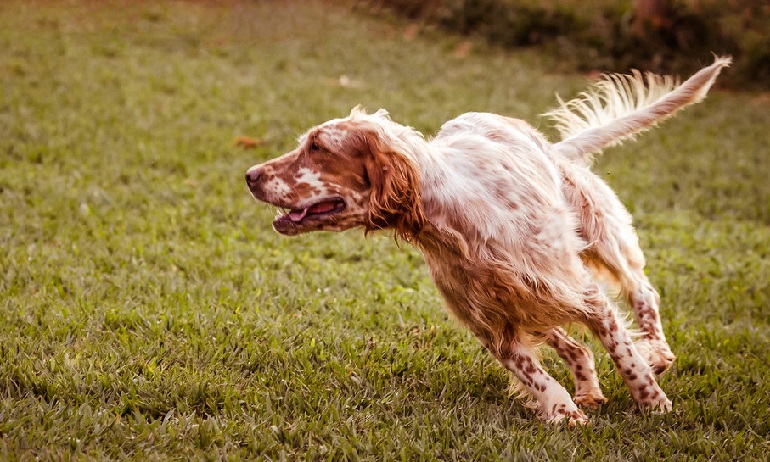
- “Jim the Wonder Dog” was a Llewellin English setter owned by a man named Sam VanArsdale in the early 1930s. He became famous for what seems like preternatural cognition: he could supposedly locate a car by make, color, out-of-state plate, or even license number.He could pick people out of a crowd based on random commands, like “find the man who sells hardware,” and he also followed commands given to him in foreign languages. He even chose the winner of seven Kentucky Derbies!
- The English setter is one of the oldest gun dog breeds, with a history that traces back to the 14th century. They are most likely descendants of the Spanish pointer, French pointer, and a variety of spaniels.
- A 4-year-old English setter named Belle won the Best in Sporting category at the 2022 Westminster Dog Show.
American Kennel Club English Setter Registrations
Along with eight other breeds, the English setter was one of the first pure-bred registrations by the AKC in 1878. In fact, the very first dog registered with the AKC (and therefore holder of the registration number “one,”) was an English setter named “Adonis.”
Although, as a breed, they were mega-popular early on, the AKC has had to put the English setter on the “Vulnerable Native Breeds” list several times in the last few decades. The good news is that in 2011 the AKC saw some big jumps in English setter registrations, with them moving up to being the 87th most popular breed in 2012.
Relationship with Humans, Especially Children
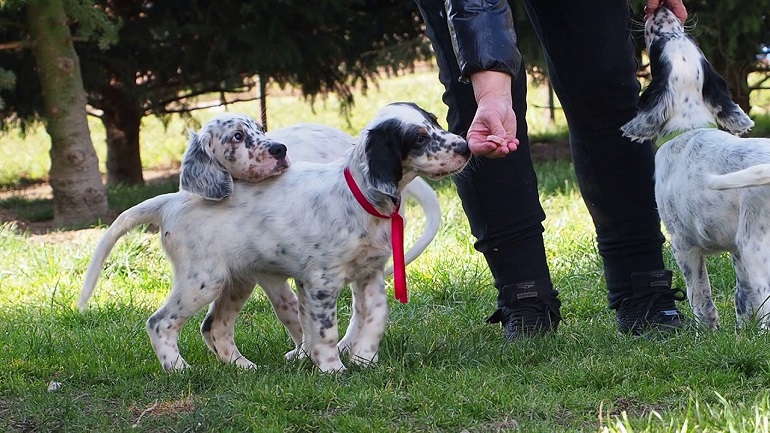
The English setter wants to be around their humans as much as possible. They thrive off interactions with their people and are not the type of dog breed that will tolerate being left alone for long periods of time.
In fact, they are prone to separation anxiety, which is when they develop bad habits – licking, barking, chewing, etc – in response to being left alone.
This super-affectionate dog loves their human family, and they do well with other pets in the house as well. Luckily for cats, their prey drive is mostly focused on birds, but some owners have found their English setter needed a little extra training to leave their feline companions alone.
When it comes to children, an English setter is usually remarkably tolerant of their shenanigans. They are very good-natured, and probably just appreciate any attention they get from their family.
The English setter makes for a good watchdog but won’t do much other than alert their family if a stranger approaches. They quiet down quickly when they realize there isn’t any danger, and then they’re likely to befriend the person more often than not.
English Setter Rescue Groups for Adoption
If you’re looking for an English setter puppy, please, don’t ever get one at a pet store. You could seek out a reputable breeder, or you could reach out to any number of rescue groups who might have dogs up for adoption.
English setter dogs are often purchased without any clear understanding of what goes into owning one (they require more mental stimulation and exercise than some other dogs), which leads to many wonderful dogs ending up in the shelter.
It’s a good idea to seek out groups in your area so that it will be easier to meet potential dogs and reduce transportation stresses, but here are a few well-recognized groups you could work with.
- Another Chance for English Setters (ACES)
- English Setter Association of America (ESAA)
- Above and Beyond English Setter Rescue (A&BESR)
- A Better English Setter Rescue
FAQ’s
Are English Setters Aggressive?
English setters are alert but not aggressive; they will bark at strangers who approach their territory but calm down very quickly when their owners tell them to.
Do English Setters Share a Good Bond With Kids?
English setters are fantastic with children! They are very tolerant of their tendencies to pull hair or invade their space and will put up with just about all toddler-inflicted torture.
In fact, many owners will probably do better training their children to respect their English Setter’s boundaries, rather than vice-versa. They also make ideal snuggle buddies for little children, as their strongest drive is to be with people at all times.
Is This Breed Housetrained?
No breed of dog comes pre-housetrained. (Wouldn’t that be nice, though?) However, English setters are highly motivated to please their owners, so they are relatively easy to train using rewards rather than disciplinary methods.
What Is the Frequency of Getting Bitten by an English Setter
The English setter is not known for being an aggressive dog, so the odds of one biting you are pretty low compared to some other dogs. The worst they’re likely to do is playfully nip to try and engage in play. This is one case of a dog’s bark being worse than their bite.
Conclusion
Although English setters are less commonly seen these days, they are fantastic dogs, particularly if you lead an active lifestyle.
Their desire to please and be around people make them wonderful companions for families who love to get outdoors and then become couch potatoes at night.


